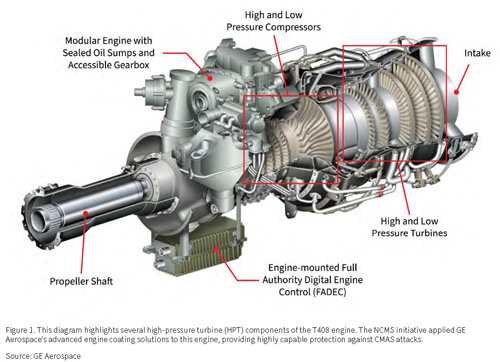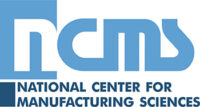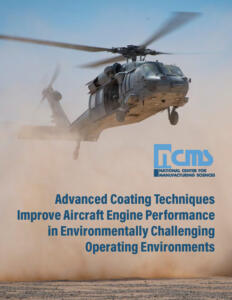NCMS Technology Briefs highlight NCMS’s cultivation and growth of innovative technologies. Through our management of government and industry collaborations, we’ve gained insights into novel approaches and best practices that can assist all companies to navigate the sometimes complex journey toward advancement. Based on the results of NCMS technology projects, the briefs show the applicability and usefulness of proven technical advances—all in an effort to speed adoption and eliminate duplication of effort. NCMS is pleased to share these insights to support U.S. manufacturing competitiveness.
View Full PDF
Introduction
Maintenance professionals tasked with keeping aircraft engines in first-rate condition face challenges with aircraft that operate in all environments, yet harsh environments where elevated temperatures, sand, dust, and saltwater can damage engines are especially challenging. In desert climates, sand deposits in aircraft engines cause compressor erosion, compromised hot-section secondary cooling, flowpath deposit buildup, and protective coating erosion and spallation. Sand deposits also lead to Calcium-Magnesium-Alumina-Silicate (CMAS) attack. The aviation industry has long recognized CMAS attack as a substantial and ongoing threat to aircraft engines.
CMAS is a form of molten siliceous residue generated at elevated temperatures within aircraft engines. CMAS adheres to the surface of thermal barrier coatings (TBCs), which are oxide ceramic coatings applied to the surfaces of metallic parts in the hottest part of gas-turbine engines, enabling modern engines to operate at significantly higher gas temperatures than their predecessors. CMAS attack has the potential to cause significant damage to engine components, resulting in TBC failures, coating spallation, and hardware degradation.
Fortunately, a new class of innovative protectants have been identified. A recent NCMS collaboration with NAVAIR, GE Global Research Center (GRC), and GE Aerospace has tested and validated that several of GE Aerospace’s advanced engine coating solutions offer highly capable protection against CMAS attacks. Through a series of demonstration projects, the collaboration team has evaluated their protective capabilities on the high-pressure turbine (HPT) components of two engines: the T408-GE-400 and the T700-701D. The T408-GE-400 is a turboshaft engine that powers the US Marine Corps’ Sikorsky CH-53K King Stallion heavy-lift helicopter. The T700-701D engine powers both the newest Sikorsky UH-60M Black Hawk and Boeing AH-64E helicopters. Having achieved excellent results during the projects, these coating solutions are currently being applied to the F414 engine of the F-18 aircraft for field testing. This will be the first platform to fly with these coatings, and a field service evaluation will be performed to provide a better understanding of the coatings’ benefits. These coatings are applicable for any aircraft operating in austere sand and/or dust environments. They will provide great potential benefits for the commercial airline industry, along with other industries utilizing aircraft.

Engine Coating Solutions
The project team has demonstrated protection from CMAS attack with the following advanced coatings:
- Electron Beam Physical Vapor Deposition (EB-PVD) Thermal Barrier Coating (TBC): ngTBC
EB-PVD Thermal Barrier Coatings (TBCs) are typically used on high-pressure turbine (HPT) airfoils, the blades used in aerospace engines. The EB-PVD TBC coating system applied in this initiative is called ngTBC, a surface treatment on top of a traditional thermal barrier coating that is CMAS-resistant, helping prevent the damage from dust, sand, or saltwater buildup from attacking the base coating. - Thermal Barrier Coating (TBC) Shield
TBC Shield is a sacrificial protective coating applied to the surface of the current TBC coating. TBC contains CMAS reactive particles that interact with the CMAS to change the properties of the deposits, leading to decreased CMAS infiltration into the thermal barrier coatings. TBC promotes shedding of the deposits, thereby reducing deposit thicknesses. - TBC Patch for On-Site Coating Repairs
TBC Patch is a method of applying a partial thickness of TBC in a region where TBC has spalled. The industry partner developed a TBC Patch repair method that can be sprayed on-site or on-wing in an engine; this patch repair would rebuild TBC thickness in the event of TBC spallation. The patch repair process was transferred to the engine hardware by grit blasting to remove TBC coating to simulate a TBC spall and then applying the TBC Patch. - TBC Slotting
This is a method of machining the TBC to reduce strains within the coating and to stop the propagation of spallation, decreasing spall sizes. TBC Slotting is actually putting slots into the coating itself, so that if the TBC starts to degrade, it will spall in a very small section versus growing over a larger surface. - Thermal Spray—High Y and Advanced High Y
The thermal spray process involved using a high temperature spray gun moved by a robot arm. “High Y” and “Advanced High Y” are two variations, with the High Y coating offering a less expensive option compared to the Advanced High Y, but with a trade-off of decreased capability. To assess performance, 33% of the combustor splash plates were coated with Advanced High Y coating, 33% of the combustor splash plates were coated with High Y coating, and 33% of the combustor splash plates were coated with standard
TBC coating.
Testing Methodology
For both engines, the team conducted an engine teardown, a labor-intensive process that disassembled each engine into its components. This method provided a unique opportunity to provide treatments at the module level. There was flexibility to perform these coating treatments in a variety of application environments from inserting tooling through borescope ports for on-wing applications to coating hardware in a partially torn apart overhaul engine. The team developed an on-site coating process, designing and manufacturing automated spray equipment to spray individual components with the coatings.
Then, the team took the treated components and rebuilt a test engine to conduct a military durability test, a field mission-based test that simulated the various levels and concentrations
of sand and saltwater ingestion encountered during fleet operations. Next, they conducted an acceptance test procedure (ATP) to document the performance as a baseline to the sand/dust/saltwater demo tests. Additionally, the hardware was visually inspected to verify acceptable condition of the advanced coatings and establish an on-engine baseline photo documentation prior to the austere environment tests. The industry partner reviewed borescopes during test execution to assess the coating’s performance. Hardware with advanced coatings met quality requirements. The engine test was run with degradation as expected. No early failure (a.k.a. “infant mortality”) of coatings
was observed, ending with a successful engine test result.
Public Benefits
Academic institutions, government labs, and the aircraft industry globally have been searching for solutions to improve aircraft engine performance when flying in difficult environmental conditions including elevated temperatures, sand, dust, and saltwater. These engine test demonstrations provided the unique opportunity to utilize a specific military application to demonstrate advanced coating technologies that will provide increased durability, performance retention, and cost reduction across multiple commercial applications to serve the public good. The coating technologies demonstrated in this initiative hold promise for potentially expanded use in both airfoil and combustor TBCs. The coatings could also potentially be transferred into other coating systems such as environmental bond coats, which are typically used on ceramic matrix composite (CMC) components, and often used in applications requiring reliability at high temperatures that are beyond the capacity of metals.
Benefits of these coating technologies include:
- Reduction in aircraft maintenance costs for aviation components
- Improved durability and performance retention for operation in austere environments
- Improved aircraft availability for operation
About NCMS
The National Center for Manufacturing Sciences (NCMS) is a cross-industry technology development consortium, dedicated to improving the competitiveness and strength of the US industrial base. As a member-based organization, it leverages its network of industry, government, and academic partners to develop, demonstrate, and transition innovative technologies efficiently, with less risk and lower cost.
NCMS enables world-class member companies to work effectively with other members on new opportunities—bringing together highly capable companies with providers and end users who need their innovations and technology solutions. NCMS members benefit from an accelerated progression of idea creation through execution.
Please note: All images in this publication, unless otherwise identified, are sourced through the DOD’s Defense Visual Information Distribution Service. Use of these images does not imply or constitute DOD endorsement.





